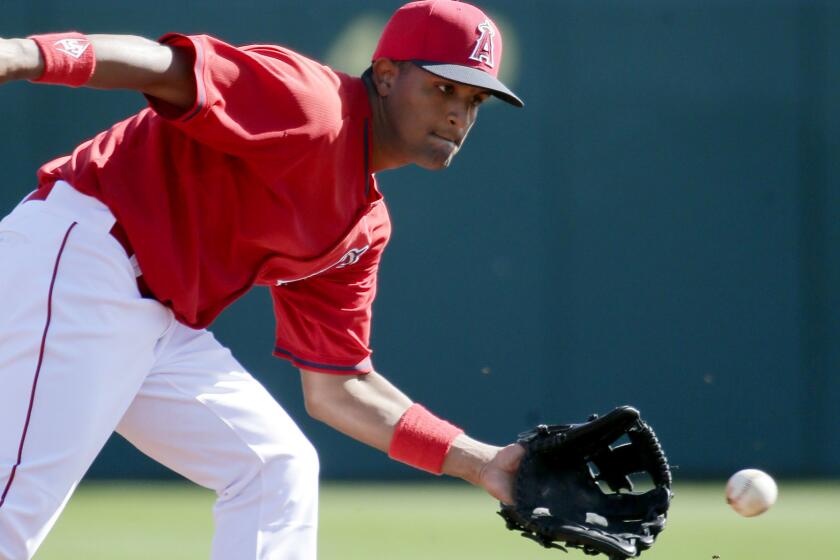Mickey Callaway asks Angels pitchers to follow smart schedule during shutdown

- Share via
Angels pitching coach Mickey Callaway has spent this nearly month-long Major League Baseball shutdown working 120 acres of land in the Florida Panhandle, soaking in quality time with his wife and two children — and conveying, from afar, to players under his supervision the importance of keeping their arms in throwing shape.
In a way, this break has made Callaway’s job easier. He has more time to devote to the minutiae than he did in spring training a month ago. When he has completed morning chores on the parcel of land he purchased during the offseason, he chats with Angels pitchers and coaches and sifts through video. He has been able to guide players through the changes they have been trying to implement in their mechanics. He has found other things for them to work on.
But the uncertainty surrounding the resumption of the baseball schedule has forced Angels pitchers, and those in other organizations, to take a potentially harmful step back in their preparation.
Callaway said in a conference call Tuesday that he has encouraged pitchers to act as though they are one week away from beginning spring training. That strategy should help pitchers minimize their risk of injury.
Major League Baseball states that holding games in one central area is one of several ideas discussed regarding how and when to start the season.
“We can stay in that suspended area as far as our shoulder and elbow strength and throwing condition,” he said. “Then, whenever they give us that heads-up, we can get after it and get going safely and healthily.”
But doing more might be a better plan. Ron Wolforth, the longtime pitching coach who has operated the Texas Baseball Ranch for nearly 30 years, cautioned against easing workloads.
“The danger is the ramp-up coming back out is too steep,” he said.
Wolforth, who has a kinesiology degree from Sam Houston State, began researching baseball’s pitching injuries in the early 1990s. He found six reasons a pitcher’s arm health can suffer — structural limitations, movement patterns, training regimens, workloads, internal body functions and preparation.
Ideally, pitchers would follow as closely as possible the routines — one or two intense throwing days, two light days and three medium-intensity days — they typically keep during a season so they can avoid health problems later.
“It’s important to cycle that in to keep that arm and the soft tissue robust,” said Wolforth, who has consulted for MLB teams and counts Justin Verlander and Trevor Bauer among his high-profile clients. “Either extreme — not doing anything or going too hard — can really be a problem. So you’ve got to thread the needle pretty carefully here.
“It’s a really good idea to act like you’re now in season and you have one bullpen [session] every five days to try to stay in cycle. That’s really important.”
Putting such a plan in practice is challenging. Equipment might be limited. In some cases, finding a catcher has been difficult.
Callaway is sure Angels pitchers are on the right track. Most starters are throwing up-down sessions — wherein the pitcher fires a predetermined amount of throws, sits for a break and gets back up to throw again, simulating a game situation — and all pitchers are throwing off mounds two to three times per week when possible.
“The one thing that kind of is a bummer is some of our starters were throwing the ball so well,” Callaway said. “[Dylan] Bundy was probably better than he’s been in a long time, according to himself, so that kind of stinks. But I think that if they continue to throw off the mound and stay ready, then we can just pick that back up.”
Slick-fielding infielder Roberto Baldoquin cost the Angels $14 million to sign out of Cuba in 2015, but he was released recently because his bat didn’t develop.
Exceptions are two-way player Shohei Ohtani and right-hander Griffin Canning. Ohtani, slated to return to pitching after spending last season recovering from Tommy John surgery, is doing long toss up to about 180 feet and “really letting it go” from a distance of 60 feet, Callaway said. Canning, slowed in spring training by elbow discomfort, is making about 50 throws a day up to 75 feet. The amended season should allow for both to factor into the major league rotation from the start.
The Angels are also providing virtual workouts. Strength and conditioning coaches have conducted video conferences to walk pitchers through arm maintenance routines. When they reconvene, the strength of their shoulders and elbows will be re-examined before they are allowed to resume work at their previous levels of exertion.
“When we start this thing up, we have to make sure that our guys are in good spots to stay healthy for the ramp up and then whatever season we play,” Callaway said. “So we’re really trying to stay on top of that.”
More to Read
Go beyond the scoreboard
Get the latest on L.A.'s teams in the daily Sports Report newsletter.
You may occasionally receive promotional content from the Los Angeles Times.









